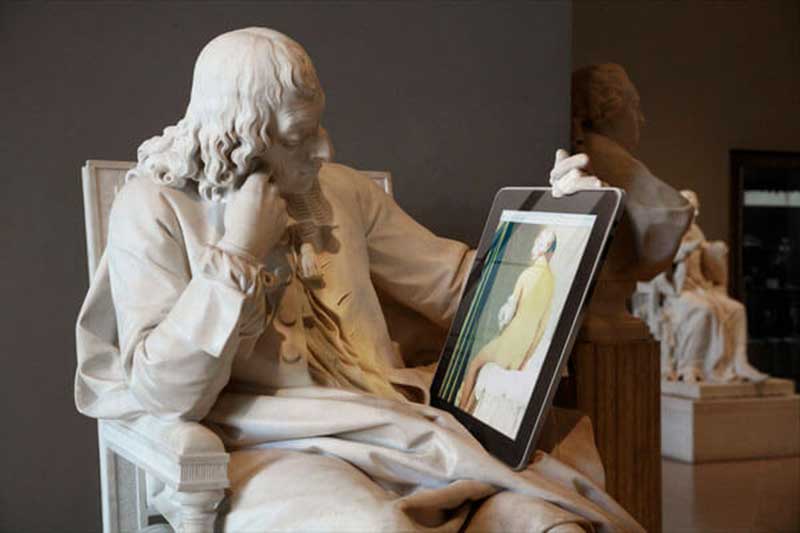- We are all engineering our future, opening up a world of creativity
- Especially in today’s connected world, art is in the eye of the beholder
- Using real-time data to create dynamic art installations
- Thanks to technology, we can now digitally recreate ancient artefacts
- Will our future computer overlords be able to create art autonomously?
Technology has provided artists with new and revolutionary ways to express their creativity for eons. Think about Andy Warhol, for instance. Would we ever have heard about him if silkscreen printing hadn’t been invented? And renowned Dutch artist Johannes Vermeer made use of light reflection and mirrors to paint his incredibly realistic interior scenes of middle class life. It is also believed that Michelangelo, to enhance the aesthetic quality of his ceiling paintings in the Sistine Chapel, used the ‘golden ratio’; the key to everything from the number of spirals on the head of a sunflower to encrypting computer data.
In fact, technology has always been a fundamental force in the evolution of art. The two have always been linked and are now more intertwined than they’ve ever been. Not only does technology make some creative processes easier, it also enables a plethora of new types of artistic expression and revolutionary new art forms which offer us, the viewer, new and exciting experiences. The future of art is upon us.
Free trendservice
We are all engineering our future, opening up a world of creativity
Engineers, software developers, inventors and scientists constantly create new human experiences. Our future is being engineered by the Internet of Things, nanotech, augmented reality, digital fabrication, 3D printing, biotech, even singularity. All of these new technologies alter our lives. They open up a whole new world of creativity for visual artists, musicians and designers and provide us with a new, thrilling view of the world around us, and indeed, ourselves. With technology, artists are able to push the boundaries of art and we are seeing static art evolve into art forms that are fluid, that adapt to their surroundings and interact with their audience. The future of art is all about interactive installations, flashmobs, 3D printed sculptures and sensor-driven creations.

Especially in today’s connected world, art is in the eye of the beholder
Traditionally, the public was nothing more than a passive observer, and it was mostly the elite who were fortunate enough to participate in creating art. And it was the critics, collectors, gallery owners and curators who determined whether an artist’s work was ‘great’ or even considered as ‘art’ and worthy of being exhibited to the public. In today’s connected world, anyone is able to create and share their art with the world. There are no more boundaries. No more restrictions. Today, creatives are able to experiment and push the envelope, surprise us and take us to new and unexpected places. True art is not about which techniques or mediums the artist chooses to use. True art is provocative. It creates a dialogue and changes the way the viewer feels and thinks.
Using real time data to create dynamic art installations
Artistry is profoundly affected by the information age and art is becoming increasingly interactive. The millions upon millions of sensors that surround us continuously take real-time measurements of everything from the weather to diseases, from light to temperature, pollution to Internet chatter, the movement of the waves to heart rates. With the data sets produced by these sensors, artists can create engaging art installations and incredible masterpieces that engage the environment and the public in interesting new ways.
The Living Light creates art with air pollution
The Living Light is a permanent outdoor structure of panels and a functional art installation in a public park in Seoul, designed by David Benjamin and Soo-in Yang of Columbia University’s Living Architecture Lab. The shape of the panels forms a map of the neighbourhoods of the city. Using 27 different sensors to provide real-time data, sections of the panel that correspond with a neighbourhood, light up every fifteen minutes in order of best to worst air quality. When an improvement is measured, the corresponding panel in the structure is illuminated. Citizens can also send text messages to the structure to get information on pollution levels in a certain area, after which the structure replies with local air quality statistics
Sea waves and sound waves create video performance art
Matt Roberts, new media artist and founder of Mobile Performance Group, specialises in real-time video performance art. His ‘Waves’ art piece responds to the changing conditions of the ocean with sound waves. Every 30 minutes, real-time data from an ocean buoy station is downloaded and transformed into low frequency sound waves. These sound waves shake water in a bowl on top of a loudspeaker. The shaking creates patterns in the water which are recorded with a video camera and projected onto a wall. The changing waves in the ocean lead to changes in the bowl of water which alter the visual projections on the wall. The result is a dynamic, artistic, audiovisual display.
Using real-time data to create a poetic interpretation of the city
Sensity is a series of ‘emergent city’ art works in which British artist Stanza, expert in art technology, makes use of environmental sensors that measure noise, light, sound, temperature and humidity. He takes his own network of wireless sensors to various cities such as London, Copenhagen and Sao Paulo and records real-time data. The data from these sensors then produces sonifications and visualisations of real-time spaces, creating a poetic interpretation of the emotional state of each city. His installations have been used by various art galleries, during prestigious events and in a number of public spaces around the world. Recurring themes throughout his career include the surveillance culture, the urban landscape and alienation in the city.
Thanks to technology, we can now digitally recreate ancient artefacts
Years of violence in the Middle East have lead to the destruction of hundreds of historic sites and ancient artefacts. One of them is the Mosul Museum in Iraq and the surrounding ruins that were smashed to pieces by large hammers and pneumatic drills. Technology has however made it possible for a group of preservationists, digitally savvy academics and artists from all over the world to virtually piece together and preserve the memory of this lost cultural heritage. Through their collaborative non-profit group Rekrei, formerly known as Project Mosul, photographs of antiquities are crowd-sourced and thousands of images have already been uploaded. With a technique called photogrammetry, these images, taken from different angles, are used to make a reconstruction of the destroyed items. Special software combines all these photos, uploaded by locals, tourists and even soldiers who were deployed there during the war, to create 3D models of the sites and artefacts that were destroyed. Project Rekrei is now broadening its scope to global heritage loss, instead of focusing on Mosul only. The group is planning to offer full, virtual reconstructions of historic sites, which can at a later stage even be physically reconstructed with 3D printing technology. The group is currently working on a virtual reconstruction of the temples and hundreds of other monuments in Kathmandu that were destroyed during the earthquake in April last year.
Will our future computer overlords be able to create art autonomously?
With developments in artificial intelligence happening at breakneck speeds, we can’t help but wonder if artificially intelligent systems are eventually capable of feelings and autonomous, artistic expression? We are not talking about the physical capability to produce art. We know they can do it, they have been producing art for decades. Take artists Harold Cohen, for instance, who programmed a machine to create a painting on canvas. This was in 1973! The machine was subsequently fed more and more programming instructions and information about the dimensions of the human body and eventually, the machine was able to produce impressive paintings of humans. Cohen argues that he taught the machine the rules of art, but the machine then went on to create its own, much like a teacher instructing a pupil. Cohen has since been followed in his footsteps by other artists who created their own artificially intelligent painting systems.
The question remains whether these machines will ever create according to their own artistic desires, without following our instructions. There is still a big difference between artificial intelligent systems that make contemporary art and autonomous AI that have the capability of expressing real interiority. This is the difference between ‘weak AI’, a system that takes over the jobs that only humans could previously do, and ‘strong AI’, a system that emulates our deep, broad and subtle human intelligence. Even though we haven’t been able to produce strong artificial intelligent systems yet, that day will come sooner than we think. With human brains essentially being biological computers, strong AI possessing emotional intelligence is a real possibility. If that would ever be the case, strong AI systems would probably also be capable of creating art, according to their own ‘desires’.
Share via:



